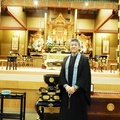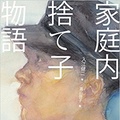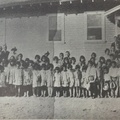When his fellow classmates in Wakayama, Japan, were engulfed in reading the popular manga of the day, growing up as a teenager in post-war Japan, Hirokazu Kosaka found his imagination transfixed by a scroll he saw at the Kozanji Temple in Kyoto. The scroll, considered to be the world’s oldest manga created in the 12th century, was the Chojyu-Jinbutsu-Giga (Animal Person Caricature) painted by Toba Sojo.
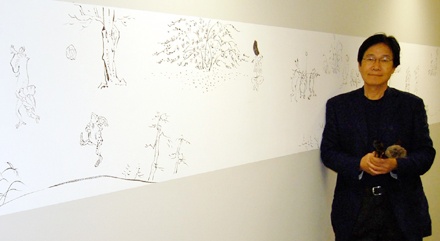
Versatile artist Hirokazu Kosaka with his interpretation of Scroll of Frolicking Animals located in the Garden Level at the Japanese American Cultural and Community Center in Little Tokyo, Downtown Los Angeles. (Courtesy of the JACCC)
Fifty years later Kosaka, now artistic director of the Japanese American Cultural and Community Center (JACCC) in Los Angeles, finds this famous scroll so clear and imbedded in his memory that Kosaka can recreate the comical scenes of monkeys and frogs without seeing a photocopy of Scroll of Frolicking Animals, the popular English title of the scroll.
Borrowing from the scroll’s English title, Frolicking Monkeys and Frogs is the title of the Kosaka’s exhibition in the JACCC’s Doizaki Gallery, from December 9–23. Admission is free to the exhibition.
The exhibition features roughly twenty pieces by Kosaka, showcasing only part of the artistic talents of this versatile artist. As a Buddhist priest, Zen archer, and artistic director of the cultural institution, Kosaka is known in Los Angeles as the consummate artist and resource.
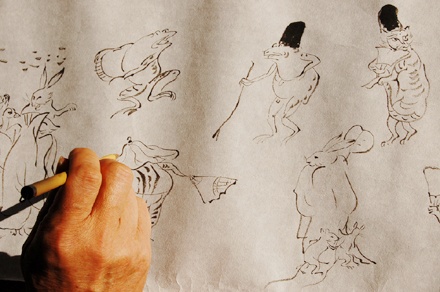
Detail of Hirokazu Kosaka’s interpretation of Scroll of Frolicking Aninals created in the 12th century in Kyoto, Japan (Courtesy of the JACCC)
Kosaka, born in Wakayama, Japan in 1948, received a full, four-year scholarship at the age of 18 to the then prestigious Chouinard Art Institute in the MacArthur Park district of Los Angeles, and graduated from the art school with a BFA in painting in 1970. Kosaka began to explore the art of performance, befriending artists such as Jack Goldstien, Wolfgang Stoerchle, Allen Ruppersberg, William Leavitt, and Chris Burden.
As a young artist, Kosaka also began to incorporate Eastern traditions in his art; drawing from his appreciation of the centuries-old traditions of Noh drama and Kabuki theater, his knowledge of the ground-breaking experimental art of Japan’s Gutai Group in the mid-1960s, as well as his own experience with Buddhist chanting and Zen archery.
In 1973, Kosaka returned to Japan where he completed a three-month long performance piece called “Soleares” (the basic format of Flamenco music) and later embarked upon a traditional 1,000-mile Buddhist pilgrimage called “The 88 Temples Visiting.”
After completing this spiritual journey, Kosaka remained at Hagyuji Temple in Niihama, Ehime prefecture and was ordained as a Shingon Buddhist priest.
He later returned to Los Angeles where he began to create large-scale, process-oriented artwork infused with the teachings he learned as a priest, and today is known for his large-scale, performance pieces, such as Kotohajime, JACCC’s annual New Year’s Day event.
Kosaka’s work has been seen and performed at venues including the Museum of Contemporary Art, Los Angeles; The Aratani/Japan America Theatre, Los Angeles; the J. Paul Getty Center; the Seattle Art Museum; and the Indianapolis Art Museum. Selected grants and awards include a Creative Capital grant, a Rockefeller Foundation grant, a COLA grant, J. Paul Getty Fellowship, Durfee Foundation Fellowship, and an NEA grant.
In Frolicking Monkeys and Frogs, Kosaka presents approximately 20 works categorized into three genres: his interpretations of Scroll of Frolicking Animals; recreations of the Japanese folk art, Otsu-e (Otsu Picture), from the late Edo Period in the 18th century; and his own depictions of insects.
Otsu-e were painted by nameless craftsmen, and sold as souvenirs to travelers at Otsu, the next station to Kyoto along the Old Tokaido Highway between Kyoto and Edo (currently Tokyo). In the 17th century, Otsu-e were sold as religious paintings of Buddha to be hung into homes of the less wealthy as objects of worship. Following that tradition, Otsu-e always featured a healthy serving of goblins and deities.
Insects have been Kosaka’s obsession since his childhood. He developed his techniques of drawing insects in his 20s when he was hired at the Natural History Museum in Los Angeles as a summer intern for three consecutive years while he attended art school.
This exhibition features a sale of all the displayed work, with proceeds benefiting the JACCC’s Visual Arts program.
Frolicking Monkeys and Frogs Painting by Hirokazu Kosaka will run through December 23, 2010 at the Doizaki Gallery of the Japanese Cultural and Community Center, 244 South San Pedro Street, Los Angeles, CA 90012. Admission is free. Gallery hours: Tuesday-Friday, 12 noon–5 pm, Saturday-Sunday, 11 am–4 pm, Closed Mondays and holidays. For more information: www.jaccc.org
*This article was originally published in Cultural News, 2010 November Issue.
© 2010 Cultural News


